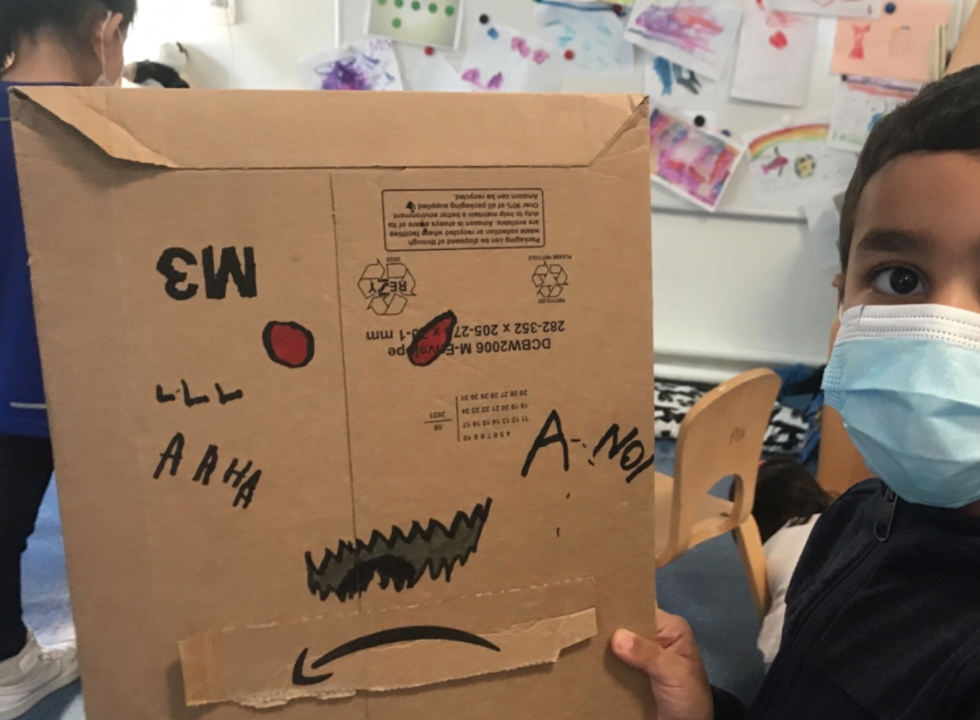Inviting Kindergarten to Write
This post is about seeking opportunities to engage Kindergarten children as writers and invite them to write in a range of meaningful ways for different purposes and audiences. Authenticity is key. Authentic contexts arise from observing children as they play and building strong relationships with them to learn more about their interests. Below are some playful ways I have introduced intentionally to help children develop their identities as writers.
Dramatic play
We have a cuddly toy for the class called Tidy. Tidy has written to the children and invited them to reply and post their ideas in a post box that is in the classroom.

After exploring the local neighbourhood, the children were invited to think about role play scenarios they might like to explore. Several children created shops, and one child created a dessert menu.
Special events
We have a range of real cards for events such as birthdays, new year, and Valentine's. These cards model the structure of different texts and key vocabulary and invite children to make their own cards, notes or gifts (with labels) for people they choose. Children have full access to glue, glitter, tape and different coloured card, paper and markers to be creative.
Museum displays
If children want to display finished or partly-finished creations such as construction pieces or artwork, they are invited to name their pieces and give them titles. Some children choose to add messages to their friends or cleaning staff about not touching their creations.
Speech
With post-it notes, including some that are shaped as speech/thought bubbles, children are invited to annotate picture books with the thoughts, feelings, or speech that might match a character. As children design characters in 2D and 3D, some add text to show speech and emotions.
Bookmaking
Children have been interested in making books that range from number books, books based on characters they have dressed up as and their own imaginative stories. I am sure children will enjoy creating non-fiction books, too. Children choose to make their own books from a variety of papers and resources such as glue, tape and staplers. Some choose to use the pre-stapled books available in the classroom.
Clipboards
Having clipboards in the classroom invites children to express themselves in different ways. Here, a child chose to survey her friends to find out their favourite food.
Children's names
There is a display of children's names and photographs in the classroom, each one on velcro so it can be taken to where a child is playing and writing. Having access to all children's names gives children confidence to write independently and create a range of texts making use of messages, cards and envelopes.
Technology
Many children enjoy using the SmartBoard or iPads and are increasingly using text to label designs, explore different ways to make marks and find places on Google Maps and Google Earth.

Loose parts
Open-ended materials often provide a stimulus for children's creative thinking. Recently, children explored fabrics and used their imagination to use these fabrics in symbolic play to become characters, develop settings or use as props. These then served as stimuli for drawings that were then connected to become stories that the children will be invited to write.
Alongside these opportunities, there have been strategic scaffolds to support children transition to more conventional writing. These include:
- explicit and systematic teaching to develop phonological awareness (a future blog post)
- alphabet strips, charts, displays and songs
- a range of literature and genres of text (including environmental print) to model quality writing
- daily discussions in response to texts read aloud to reinforce the connection between reading and writing
More invitations
After just participating in Jo Fahey's wonderful workshop on Playful Literacies, I now have a set of new ideas to continue to invite Kindergarten children to engage as writers.
- Write raps, rhymes and songs to then compile as anthologies to read
- Have storage baskets of clipboards, paper and pens inside and outside
- Actively invite children to write in their home languages
- Invite children to share their writing with the class on the stool (author's chair)
- Invite children to create signs and symbols for small world play or socio-dramatic play
- Create and label maps of places ranging from the classroom, school, local area, countries to the world!
December 2022 Update
It has been an ongoing inquiry into exploring ways to promote writing in playful ways.
This month, the children were invited to draw and write items on a wish list to show things they would like outside and inside in their play.
We also introduced some playful tools and resources to encourage children to develop their identities as writers. These included pens with 'invisible ink', pencil cases, multicoloured pens, beautifully decorated note paper and envelopes.
I noticed children were naturally engaged as storytellers in their play, especially in their use of loose parts and how narratives were developed. Inspired by the thinking of Story Workshop, I offered to type children's stories as they dictated them to me. This modelling proved to be powerful in showing children their voice and ideas mattered, and many children were inspired to draw and write their own stories.
I now organise a weekly writing session called 'Personal Writing' which invites children to draw and write in any genre of their choice, following a brief shared writing session.
In a recent session with PressPlay, Kym Scott advocated for the idea of how writing might enhance children's play. This inspired a conversation with one group of children who were planning a show for another class about writing invitations to the class. Other ideas could include menus, shopping lists, traffic signs, tickets for sports games, labels etc. depending on the children's play choices.
Reflection:
What do you do to invite children to write, honouring children's choices, interests and developmental levels?
What might you offer next?


















Comments
Post a Comment